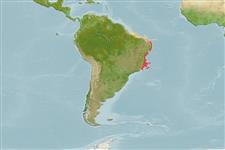Teleostei (teleosts) >
Ovalentaria/misc (Various families in series Ovalentaria) >
Pomacentridae (Damselfishes) > Chrominae
Etymology: Chromis: Greek, chromis = a fish, perhaps a perch (Ref. 45335); jubauna: From a contraction from the Tupi-Guarani words 'juba' meaning yellow and 'una' meaning black, in reference to its distinctive coloration (Ref. 27310).
Environment: milieu / climate zone / depth range / distribution range
Ecology
Marine; reef-associated; depth range 10 - 70 m (Ref. 27310). Tropical; - 22°S
Southwest Atlantic: Brazil.
Size / Weight / Age
Maturity: Lm ? range ? - ? cm
Max length : 7.4 cm SL male/unsexed; (Ref. 27310)
Dorsal spines (total): 13; Dorsal soft rays (total): 11 - 12; Anal spines: 2; Anal soft rays: 9 - 11; Vertebrae: 23. Color black in life, paler ventrally. Caudal peduncle and fin and upper 3/4 of soft dorsal fin yellow; black anal and pelvic fins (some have very small yellow spots on tips of anal rays); transparent or yellowish pectoral fin, with a dark spot at axil; pectoral spot remains visible in preserved specimens. Oblique mouth; a small, opercle with a flat spine posteriorly, aligned with the pupil, its margin smooth with a round corner; lower edge of suborbitals scaled. Tubed lateral line scales, 15-17; pored scales on mid-posterior part of body and caudal peduncle 10-13; branchiostegal rays 6; predorsal bones 3. (Ref. 27310).
Adults are found in open areas with great water circulation over rocky bottom; usually in groups, 4-5 m above the substrate, seeking shelter on the bottom when there are predators (Ref. 27310). Maximum depth from Ref. 126840. Oviparous, distinct pairing during breeding (Ref. 205). Eggs are demersal and adhere to the substrate (Ref. 205). Males guard and aerate the eggs (Ref. 205).
Life cycle and mating behavior
Maturity | Reproduction | Spawning | Eggs | Fecundity | Larvae
Oviparous, distinct pairing during breeding (Ref. 205). Eggs are demersal and adhere to the substrate (Ref. 205). Males guard and aerate the eggs (Ref. 205).
Leão de Moura, R., 1995. A new species of Chromis (Perciformes: Pomacentridae) from the southeastern coast of Brazil, with comments on other species of the genus. Rev. Fr. Aquariol. 21(3-4):91-96. (Ref. 27310)
IUCN Red List Status (Ref. 130435: Version 2024-2)
Threat to humans
Harmless
Human uses
Tools
Special reports
Download XML
Internet sources
Estimates based on models
Preferred temperature (Ref.
123201): 25 - 27.6, mean 27.3 °C (based on 130 cells).
Phylogenetic diversity index (Ref.
82804): PD
50 = 0.5000 [Uniqueness, from 0.5 = low to 2.0 = high].
Bayesian length-weight: a=0.01820 (0.00804 - 0.04119), b=2.99 (2.81 - 3.17), in cm total length, based on LWR estimates for this Genus-body shape (Ref.
93245).
Trophic level (Ref.
69278): 3.0 ±0.1 se; based on size and trophs of closest relatives
Resilience (Ref.
120179): High, minimum population doubling time less than 15 months (Preliminary K or Fecundity.).
Fishing Vulnerability (Ref.
59153): Low vulnerability (10 of 100).
